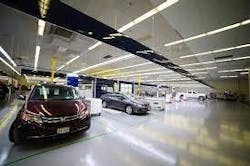Dealership shop operator built model that correctly identified industry trends
As a trainer and consultant, I sometimes run into shop owners who, as I see it, have a convoluted idea of how to make their business successful. It’s like they have a can of chicken soup but think they’re going to get filet mignon out of it.
That’s why it’s always exciting and refreshing to share a conversation with those who I see as more like-minded and clear-eyed about where they are, where they are going, and how they are going to get there.
For a long time, I’ve seen Mike Giarrizzo as one of those people.
Without going back further into his career in the industry, since 2005 Mike has been the CEO of DCR Systems, which currently operates eight shops in four states in partnerships with auto dealers. The company’s model and philosophy are innovative, and despite Mike jokingly saying that it sometimes feels like a “16-year R&D project,” it clearly is proving successful. Since the beginning, he and his team have been at the forefront, seeing the direction they believed collision repair was heading.
“We founded the company under the premise that the complexity of the vehicles was increasingly going to drive them back to the manufacturer through the dealer,” Mike told me recently. “We believed customers will feel more and more comfortable going back to a dealer that has world-class collision centers. We believed back then that the information needed to fix the cars was going to become more and more scarce to the average shop owner, but would be provided to those pursuing the education and certifications.”
Mike said they may have been a little premature with that thinking back in 2005.
“When you’re blazing trials, it’s not always the greenest path,” he said. “But we believe more today than ever that our business model is right, and ripe for growth, and for the right reasons.”
In a single conversation I had with Mike recently, he shared nearly two dozen items related to his company’s beliefs, practices and predictions that I thought were relevant to share here with the industry. Here are a just a few.
Identify any defect at the step in the process where it’s occurred. All the costs associated with a defect – repeated work, lost opportunity, delays in other production – can be reduced significantly if that problem is caught right away, rather than later in the process.
“We have figured out that letting that defect go downstream, the amount of labor and materials put into that vehicle are 10-fold over what it would be if the defect was caught in that step of the process, through an effective inspection and verification stage,” Mike said. “You can correct it right there at a fraction of the cost. And recording the information about what happened allows you to look for common trends.”
Computers and management are too slow. “That’s something a mentor of mine years ago would say, and back then, I didn’t quite understand what he was talking about,” Mike said. “But what he meant was: If the team has to stop to go search out management to figure out what to do next or go find a computer to figure out what to do next, it’s waste.”
The DCR production system, accordingly, uses visual clues and other tools to “pull work” through the shop, making it immediately clear to every team member what’s next when they finished their task on a vehicle.
Technician experience now takes a back seat to the ability to follow procedures. “It’s no longer about how well you can shape that panel,” Mike said. “It’s really about the commitment to following manufacturer’s work instructions.”
In other works, a technician might have the skill to straighten a panel or make other repairs, but that doesn’t matter if that’s not something the manufacturer allows under its repair procedures.
“It’s not a matter of if you can repair that; you can repair almost anything,” Mike said. “It’s: Should it be repaired?”
I’ll share more from my conversation with Mike in a future column.
About the Author
Steven Feltovich
Steve Feltovich of SJF Business Consulting, LLC, works with dealers, MSOs and independent collision repair businesses to make lasting improvements and achieve performance goals. He has more than three decades of automotive industry experience, including 17 years with Sherwin-Williams Automotive Finishes. Connect with Feltovich on LinkedIn.

